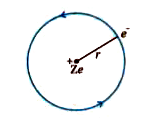Text Solution
Verified by Experts
|
Topper's Solved these Questions
ATOMS
KUMAR PRAKASHAN|Exercise TRY YOURSELF |43 VideosView PlaylistATOMS
KUMAR PRAKASHAN|Exercise SECTION-B (NUMERICALS) (Numerical From Textual Illustrations)|9 VideosView PlaylistALTERNATING CURRENTS
KUMAR PRAKASHAN|Exercise SECTION-D MCQs (COMPETITIVE EXAMS)|64 VideosView PlaylistBOARD'S QUESTION PAPER MARCH-2020
KUMAR PRAKASHAN|Exercise PART-B SECTION -C|4 VideosView Playlist
Similar Questions
Explore conceptually related problems
Knowledge Check
A
B
C
D
Submit
A
B
C
D
Submit
A
B
C
D
Submit
Similar Questions
Explore conceptually related problems
KUMAR PRAKASHAN-ATOMS-Section-D -MCQs asked in GUJCET / Board Exam
- Using the formula for the radius of nth orbit r(n)=(n^(2)h^(2)epsi(0))...
07:18
|
Playing Now - The ratio of longest wavelength and the shortest wavelength observed i...
03:36
|
Play - Which line of the Balmer series has the maximum wavelength ?
Text Solution
|
Play - As the quantum number increases, the difference of energy between cons...
00:59
|
Play - In Rutherford's alpha-scattering experiment, what will be the correct ...
Text Solution
|
Play - The potential energy of the orbital electron in the ground state of hy...
01:35
|
Play - What will the angular momentum in fourth orbit, if L is the angular mo...
01:47
|
Play - The ratio of areas of the electron orbits for the first excited state ...
02:16
|
Play - What is the difference of angular momenta of an electron between two c...
01:51
|
Play - The ratio of kinetic energy of the total energy of an electron of a Bo...
01:02
|
Play - The potential difference applied to an X-ray tube is 5 kV and the curr...
01:28
|
Play - For an electron in the second orbit of Bohr's hydrogen atom, the momen...
00:55
|
Play - of the following transitions in the hydrogen atom, the one which gives...
03:17
|
Play - The relation between principle quantum number (n) and orbital radius (...
01:00
|
Play - The total energy of an electron in second excited state is - 2E. What ...
01:00
|
Play - The atom of hydrogen absorbs 12.75 eV of energy in ground state. Then ...
02:59
|
Play - Find out the atomic number of the element which gives X-ray of minimum...
02:43
|
Play - The minimum wavelength of the X-rays produced by electrons accelerated...
01:07
|
Play - Write range of wave length of X - rays.
01:11
|
Play - If , lambda(1) and lambda(2) are the wavelength of the numbers of th...
02:44
|
Play - Number of spectral line of hydrogen atom is
Text Solution
|
Play
